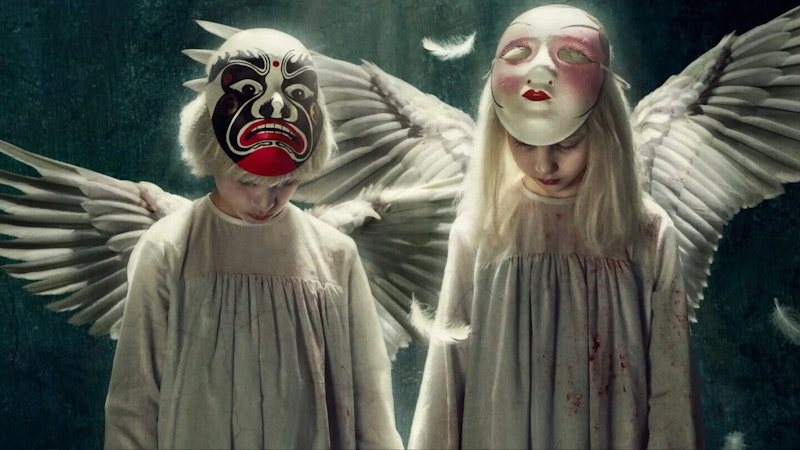The symbol of evil children in horror stories is a familiar one. Part of that literary and cinematic trope is the inevitable unsettling at witnessing a human being fundamentally and naturally innocent act in a strange and twisted manner. Tin and Tina, a new Spanish horror movie directed by Rubin Stein, streaming on Netflix, explores what happens when children’s play turns deadly.
The film takes place in 1981, and Lola and Adolfo are a married couple very much in love. At the outset, we see a Catholic wedding consistent with the Latin Rite, and there’s an immediate indication that religion will play a prominent part in the film. Right after the wedding, Lola experiences a miscarriage, and is told that she’ll never be able to have children again. Lola and Adolfo decide to go to the nearby convent that also houses orphans, and adopt a child. Although, at first, their intent is to adopt a baby or a very young child, they encounter two odd-looking children, Tin and Tina (named after Saint Augustine), a twin brother and sister. Feeling pity, Lola pleads with Adolfo to adopt them.
Life with Tin and Tina is strange. They’re overly Catholic and scrupulous. They place crucifixes all over the house, and regularly quote the Bible. They’re also highly judgmental of Lola’s faithlessness and questioning of God’s existence. The children’s scrupulosity can be forgiven given the fact that they grew up in a convent under the thumb of a sadistic nun. But their obsession with judgment and punishment takes an outward turn when their actions become supernatural events.
Lola grows apart from the children because she starts to notice strange things happening to her. Children’s prayers have an evil undertone, her hair begins to fall out, and the children dismember the family dog because they wanted to “cleanse his soul.” Adolfo, who’s a pilot, isn’t as available as he should be, and he dismisses Lola’s concerns. In the meantime, Lola is miraculously pregnant. The children tell her it’s because they asked God for it.
The final straw for Lola comes when Tin and Tina nearly drown the new baby in an attempt to baptize him. Every action they do is punctuated by visions of punishment and strange justice that only makes sense to the children. Adolfo finally realizes that Tin and Tina don’t belong in their house, and they’re returned to the convent.
Naturally, this isn’t the end to their evil child’s play, and in the final act of “cleansing,” they somehow, remotely set the house on fire. Or at least, that’s the implication in the film, which relies heavily on ambiguity of evil. This is often a big element of any horror film: questioning reality is what gives a horror story its meaning. But Tin and Tina only hovers on the surface of this meaning.
Although it starts out strongly, it ends up devolving into a series of signifiers which never move beyond its superficial allusions. Lola has a wooden leg, the twins are the echoes of Stanley Kubrick’s The Shining (1980) and Richard Donner’s The Omen (1976), and Lola’s cut hair is reminiscent of Mia Farrow in Roman Polanski’s Rosemary’s Baby (1968). None of these allusions are necessarily bad but they’re deployed in a way that renders the film a pastiche of various horror cliches. They do not honor the cinematic precedents. Rather, they’re used in a lazy manner.
Generally speaking, Spanish and Latin American horror stories are almost always intertwined with religion, especially Catholicism. The line between paganism and monotheism is very thin and this is what makes such stories fascinating. There’s always much to explore: a person’s lack of faith, a worship that borders on scrupulosity, a religious ecstasy that’s on the edge of madness. But Stein misses a lot of opportunities. (For example, J. A. Bayona’s 2007 El orfanato captures the nuance of evil, as well as the elements of Spanish horror in a more arresting way.)
Tin and Tina is visually and aesthetically beautiful. Stein has a painter’s eye, which can lead to solid cinematic choices but the story of Tin and Tina doesn’t have a depth that matches the visual aspects of the film. What’s missing is the interiority of Catholic spiritual experience and an understanding of true demons within us.

